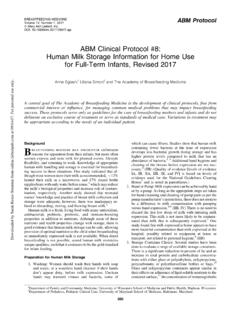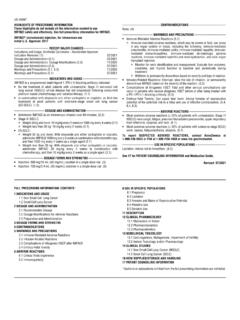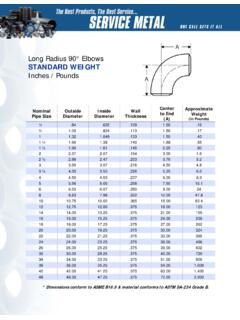Transcription of ABM Clinical Protocol #3: Supplementary Feedings in the ...
1 ABMP rotocolABM Clinical Protocol #3: Supplementary Feedings in the HealthyTerm Breastfed Neonate, Revised 2017 Ann Kellams,1 Cadey Harrel,2 Stephanie Omage,3 Carrie Gregory,4,5 Casey Rosen-Carole,4,5and the Academy of Breastfeeding MedicineA central goal of The Academy of Breastfeeding Medicine is the development of Clinical protocols for managingcommon medical problems that may impact breastfeeding success. These protocols serve only as guidelines for thecare of breastfeeding mothers and infants and do not delineate an exclusive course of treatment or serve as standardsof medical care. Variations in treatment may be appropriate according to the needs of an individual Used in This Protocol Exclusive breastfeeding:Feeding only breast milk (at thebreast or own mothers expressed breast milk), no food orwater except vitamins, minerals, and medications. Supplementary Feedings :Additional fluids provided toa breastfed infant before 6 months (recommended du-ration of exclusive breastfeeding).
2 These fluids mayinclude donor human milk, infant formula, or otherbreast milk substitutes ( , glucose water). Complementary Feedings :Solid or semisolid foodsprovided to an infant in addition to breastfeeding whenbreast milk alone is no longer sufficient to meet nutri-tional needs. Term infant: In this Protocol term infant also includesearly-term infants (gestational age 37 38 6/7 weeks).BackgroundGiven early opportunities to breastfeed, breastfeeding as-sistance, and instruction the vast majority of mothers andinfants will successfully establish breastfeeding. Althoughsome infants may not successfully latch and feed well duringthe first day (24 hours), most will successfully breastfeedwith time, appropriate evaluation and support, with minimalintervention. Exclusive breastfeeding for the first 6 months isassociated with the greatest protection against major healthproblems for both mothers and 3 Unfortunately,infant formula supplementation of healthy neonates in hos-pital is commonplace,4,5despite widespread recommenda-tions to the 8 Early supplementation with infantformula is associated with decreased exclusive breastfeedingrates in the first 6 months and an overall shorter duration ,10 Therefore, hospitals, healthcare facilities,and community organizations that promote breastfeeding areintegral in improving the exclusivity and duration of way of achieving this is by following The TenSteps to Successful Breastfeeding (the basis for the Baby-Friendly Hospital Initiative)
3 , both in the hospital physiologySmall quantities of colostrum are appropriate for the sizeof a newborn s stomach,11 13prevent hypoglycemia in ahealthy, term, appropriate for gestational age infant,14,15andare easy for an infant to manage as he/she learns to coordinatesucking, swallowing, and breathing. Healthy term infantsalso have sufficient body water to meet their metabolic needs,even in hot 18 Fluid necessary to replace insen-sible fluid loss is adequately provided by breast ,18 Newborns lose weight because of physiologic di-uresis of extracellular fluid following transition from intra-uterine to extrauterine life and the passage of meconium. In aprospective cohort of mothers in a Baby-Friendly des-ignated hospital with optimal support of infant feeding, themean weight loss of exclusively breastfed infants was ;notably, greater than 20% of healthy breastfed infants lostmore than 7% of their study of over 160,000healthy breastfed infants resulted in the creation of hour-specific nomograms for infant weight loss for exclusivelybreastfed newborns that showed differentially increasedweight loss in those born by cesarean section than by vaginalbirth.
4 In this study, almost 5% of vaginally born infants and1 Department of Pediatrics, University of Virginia, Charlottesville, of Family & Community Medicine, University of Arizona College of Medicine and Family Medicine Residency, Tucson, of General Practice, The University of Queensland, Brisbane, of4 Pediatrics and5 OBGYN, University of Rochester, Rochester, New MEDICINEV olume 12, Number 3, 2017 Mary Ann Liebert, : >10% of those born by cesarean section had lost 10% oftheir birth weight by 48 hours after birth. By 72 hours,>25%of infants born by cesarean section had lost 10% of theirbirth infants regain birth weight at anaverage of days (95% confidence interval: days)with having regained their birth weight by 21 should be followed closely to identify those who lieoutside the predicted pattern, but the majority of thosebreastfed infants will not require supplementation.
5 It shouldalso be noted that excess newborn weight loss is correlatedwith positive maternal intrapartum fluid balance (receivedthrough intravenous fluids) and may not be directly indicativeof breastfeeding success or ,23 Early management of the new breastfeeding motherSome breastfeeding mothers question the adequacy ofcolostrum Feedings and perceive that they have an insuffi-cient milk ,25 These women may receive conflictingadvice about the need for supplementation and would benefitfrom reassurance, assistance with breastfeeding technique,and education about the normal physiology of breastfeedingand infant behavior. Inappropriate supplementation mayundermine a mother s confidence in her ability to meet herinfant s nutritional needs26and give inappropriate messagesthat may result in supplementation of breastfed infants of infant formula or other supplementsmay decrease the feeding frequency of the infant, therebydecreasing the amount of breast stimulation a mother re-ceives, which results in a reduction of milk mothers with low confidence levels are veryvulnerable to external influences, such as advice to offerbreastfeeding infants supplementation of glucose water orinfant formula.
6 Well-meaning healthcare professionals mayrecommend supplementation as a means of protectingmothers from fatigue or distress, although this can conflictwith their role in promoting 31 Several so-ciodemographic factors are associated with formula supple-mentation in the hospital, and vary geographically. It isimportant to recognize and address these factors in a cultur-ally sensitive manner. Inappropriate reasons for supplemen-tation and associated risks are multiple (Appendix Table A1).There are common Clinical situations where evaluation andbreastfeeding management may be necessary, but SUPPLE-MENTATION IS NOT INDICATED, including:1. The healthy, term, appropriate for gestational age infantwhen the infant is feeding well, urinating and stoolingadequately, weight loss is in the expected range, andbilirubin levels are not of concern (depending on ges-tational age, time since birth, and any risk factors).
7 32 Newborns are normally sleepy after an initial alertperiod after birth (*2 hours). They then have vari-able sleep wake cycles, with an additional one ortwo wakeful periods in the next 10 hours whether fedor Careful attention to an infant s early feeding cues,keeping the infant safely skin-to-skin with motherwhen she is awake, gently rousing the infant toattempt frequent breastfeeds, and teaching themother hand expression of drops of colostrum,34may be more appropriate than automatic supple-mentation after 6, 8, 12, or even 24 hours. Increased skin-on-skin time can encourage morefrequent feeding. Ten percent weight loss is not an automatic mar-ker for the need for supplementation, but is anindicator for infant The infant who is fussy at night or constantly feedingfor several hours Cluster feeding (several short feeds close together)is normal newborn behavior, but should warrant afeeding evaluation to observe the infant s behaviorat the breast35and the comfort of the mother to en-sure that the infant is latched deeply and effectively.
8 Some fussy infants are in pain that should be The tired or sleeping mother Some fatigue is normal for new mothers. However,rooming out for maternal fatigue does not improvemothers sleep time36and has been shown to reducebreastfeeding fatigue shouldbe evaluated for the safety of mother and baby toavoid falls and Breastfeeding management that optimizes the infantfeeding at the breast may make for a more satisfiedinfant AND allow the mother to get more following guidelines address strategies to prevent theneed for supplementation (also see Appendix 2) as well as indi-cations for and methods of supplementation for the healthy, term(37- to 42-week), breastfed infant. Indications for supplementa-tion in term, healthy infants are ,39 Table 1 lists possibleindications for the administration of supplemental feeds. In eachcase, the medical provider must decide if the Clinical benefitsoutweigh the potential negative consequences of such 1.
9 Prevent the need for supplementation1. There is mixed, but mainly positive, evidence about therole of antenatal education and in-hospital support on therates of exclusive 42(I)(Qualityofevi-dence [levels of evidence I, II-1, II-2, II-3, and III] is basedon the Preventive Services43 Task Force Appendix ATask Force Ratings and is noted in parentheses.)2. All staff who care for postpartum women should be ableto assist and assess breastfeeding infants, especiallywhen other staff with expertise are not Both mothers and healthcare professionals should beaware of the risks of unnecessary Healthy infants should be placed skin-to-skin with themother, if she is awake and alert, immediately afterbirth to facilitate ,44(I) The delay intime between birth and initiation of the first breastfeedis a strong predictor of infant formula use and mayaffect future milk ,45,46(II-3, II-2, II-3)5.
10 It is ideal to have the mother and infant room-in24 hours per day to respond to infant feeding cues,enhance opportunities for breastfeeding, and hencesecretory activation (lactogenesis II).7,39,47,48(III)6. If mother infant separation is unavoidable, milk supplyis not well established, or milk transfer is inadequate,the mother needs instruction and encouragement toexpress her milk by hand or pump to stimulate milk2 ABM Protocol production and provide expressed milk for the ,39,48,49(I, III) This process should begin (II-2)Step 2. Address early indicators of the possible needfor supplementation1. The infant s medical providers should be notified if theinfant or mother meets any criteria for supplementa-tion, as listed in Table All infants must be formally evaluated for position,latch, and milk transfer before the provision of sup-plemental Feedings .







